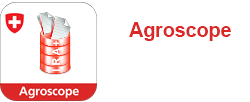Despite the widespread acceptance of the ‘three-pillar’ model for sustainability – environmental, social and economic – there is still a serious lack of technically and practically feasible data-collection solutions for use in conducting a quantitative sustainability assessment of agricultural holdings. Various methods intended to provide a comprehensive assessment of sustainability at the farm level are available. However, most of them suffer from either a failure to provide a clear conceptual framework, insufficient thematic coverage (e.g., ignoring animal welfare or landscape quality) or both. Therefore, Agroscope has recently completed a project that aimed to develop a scientifically sound set of indicators of the most relevant aspects of sustainability, following a life-cycle approach (Roesch et al., 2017). The developed method, SALCASustain, includes a comprehensive evaluation of the following impact categories: resource use, global warming, eutrophication and acidification, ecotoxicity, biodiversity, soil quality, economic sustainability, and social sustainability. Serious gaps remain, particularly in the development of feasible indicators for the socio-economic dimension of sustainability, as well as some environmental indicators. Therefore, we placed a special focus on advancing the following aspects of sustainability: (1) social sustainability: physical and mental workload and the aesthetic value of the agricultural landscape; (2) ecotoxicity, biodiversity and soil quality and (3) economic indicators, which reflect the long-term economic viability of agricultural holdings. In order to test this set of sustainability indicators under real-life conditions, the SustainFarm project was launched in 2016. This project aims to determine the scientific soundness and feasibility of the indicator system on ten farms in Switzerland, including data acquisition, the computation of the sustainability indicators, the analysis and the feedback to the individual farmer. This paper discusses the first results of the entire process, i.e., the experience gained during data collection, the communication with the farmers and the computation of the indicators, as well as the significance of the indicator set for estimating the overall sustainability of the investigated farms. Based on these results, ways to improve the SALCASustain method and its implementation will be discussed and implemented. At the current stage of the work, we can conclude the following: (1) the computation of indicators requires a great deal of manpower due to the demanding data preparation process; (2) timely data acquisition at a reasonable accuracy is a demanding process and requires a well-developed data flow between farmers, the parties collecting the data and indicator specialists and (3) the interpretation of the results provides deep insights into the relationships between the various sustainability indicators.
Roesch A., Bystricky M., Nyfeler-Brunner A., Baas H.
Assessment of sustainability indicators on farms under real-life conditions.
Dans: 13th European IFSA Symposium. 1-5 July, Ed. IFSA, Chania, Greece. 2018, 1-20.
Téléchargement anglais (1117 kB)
ID publication (Code web): 39467 Envoyer par e-mail










